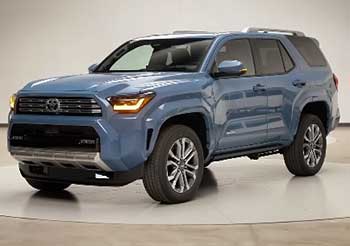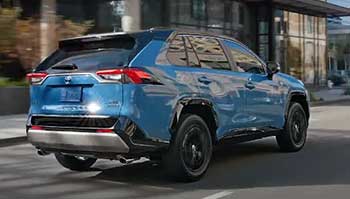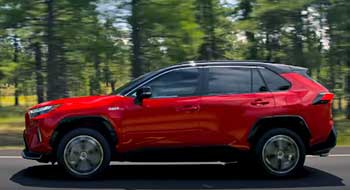As a car enthusiast who’s spent countless hours behind the wheel of SUVs, I’ve always been drawn to Toyota’s lineup for their reliability and versatility.
Today, I’m breaking down the Toyota 4Runner and Toyota RAV4, two SUVs that cater to different lifestyles but share Toyota’s reputation for quality.
My goal is to help you decide which one fits your needs by comparing their features, performance, and practicality.
Through my firsthand experiences and detailed analysis, I’ll highlight the pros, cons, and key differences to guide your decision-making process.
Comparison Table: Toyota 4Runner Vs. Toyota RAV4
| Feature | Toyota 4Runner | Toyota RAV4 |
|---|---|---|
| Base Price | $42,220 | $28,675 |
| Engine | 2.4L Turbo 4-cylinder or 2.4L Turbo Hybrid (278-326 hp) | 2.5L 4-cylinder or Hybrid (203-219 hp) |
| Fuel Economy | 17-23 MPG combined | 30-39 MPG combined |
| Towing Capacity | Up to 6,000 lbs | Up to 3,500 lbs |
| Ground Clearance | 9.2 inches | 8.6 inches |
| Cargo Space | 89.7 cu. ft. | 69.8 cu. ft. |
| Seating | 5-7 passengers | 5 passengers |
| Drive Type | RWD or 4WD | FWD or AWD |
| Off-Road Capability | Advanced (Crawl Control, locking differential) | Moderate (AWD, multi-terrain select) |
| Infotainment | 8-14 inch touchscreen, Apple CarPlay, Android Auto | 8-10.5 inch touchscreen, Apple CarPlay, Android Auto |
| Safety Rating | 4/5 (NHTSA) | 5/5 (NHTSA), IIHS Top Safety Pick+ |
My Experience With Toyota 4Runner
Driving the Toyota 4Runner feels like commanding a tank through the wilderness. My first ride was on a rocky trail in the Rockies, where its 9.2 inches of ground clearance and optional Crawl Control made light work of uneven terrain. The body-on-frame construction gives it a rugged, truck-like feel, perfect for those who crave adventure.
Inside, the cabin is functional but dated, with chunky knobs and a straightforward layout that prioritizes utility over luxury. The 2.4-liter turbo engine (or the hybrid option) delivers 278-326 horsepower, plenty for towing up to 6,000 pounds, but the 17-23 MPG combined fuel economy had me stopping at gas stations more often than I’d like.
The 4Runner’s spacious interior, with up to 89.7 cubic feet of cargo space, easily swallowed my camping gear, and the optional third-row seating is a boon for larger families. However, the stiff suspension and heavy steering made city driving less enjoyable, and the outdated five-speed transmission (on non-hybrid models) felt sluggish compared to modern competitors.
Still, its off-road prowess and legendary reliability kept me grinning, especially when I tackled muddy paths with confidence. For those prioritizing durability and off-road capability over daily comfort, the 4Runner is a dream ride.
Pros Of Toyota 4Runner

- Exceptional Off-Road Capability: The 4Runner’s 9.2-inch ground clearance, available Crawl Control, and locking rear differential make it a beast on rough terrain, ideal for overlanding or backcountry adventures.
- High Towing Capacity: With a maximum towing capacity of 6,000 pounds, it easily handles trailers, boats, or heavy equipment, surpassing many competitors in its class.
- Spacious Cargo Area: Offering 89.7 cubic feet of cargo space with seats folded, it’s perfect for hauling gear for camping, moving, or family trips.
- Optional Third-Row Seating: Available seven-passenger seating accommodates larger families, a feature not found in the RAV4.
- Legendary Reliability: Built on a truck-like frame, the 4Runner boasts a 9.4/10 reliability rating from iSeeCars, ensuring long-term durability.
- Versatile Drive Options: Available rear-wheel or four-wheel drive, with part-time or full-time 4WD systems, offers flexibility for various driving conditions.
- Robust Engine Options: The 2.4-liter turbo or hybrid powertrain delivers 278-326 horsepower, providing ample power for demanding tasks.
Cons Of Toyota 4Runner
- Poor Fuel Economy: Averaging 17-23 MPG combined, it’s significantly less efficient than competitors like the RAV4, leading to higher fuel costs.
- Dated Interior Design: The cabin feels utilitarian with hard plastics and an outdated layout, lacking the refinement of modern SUVs.
- Stiff Ride Quality: The truck-based frame and soft suspension make for a bumpy ride on paved roads, less comfortable for daily commuting.
- Higher Starting Price: At $42,220, it’s notably pricier than the RAV4, which may deter budget-conscious buyers.
- Sluggish Transmission: The five-speed automatic (on non-hybrid models) feels outdated, with slower shifts compared to competitors’ eight-speed options.
- Limited Rear Legroom: Rear passengers have less legroom than in the RAV4, making it less ideal for long trips with adults in the back.
- Larger Turning Radius: Its wider turning radius makes it harder to maneuver in tight city spaces or parking lots.
Maintenance Tips For Toyota 4Runner
- Regular Oil Changes: Change the oil every 5,000-7,500 miles to maintain engine health, especially given the 4Runner’s demanding V6 or turbo engine.
- Tire Rotations: Rotate tires every 6,000 miles to ensure even wear, particularly important for off-road driving with all-terrain tires.
- Check 4WD System: Inspect the four-wheel-drive system annually, including transfer case fluid, to ensure optimal performance during off-road use.
- Brake Inspections: Check brake pads and rotors every 15,000 miles, as the 4Runner’s weight and towing capacity can accelerate wear.
- Suspension Maintenance: Lubricate suspension components every 30,000 miles to maintain off-road capability and ride quality.
- Battery Care: Test the battery every two years, especially in extreme climates, to avoid failures during off-grid adventures.
- Air Filter Replacement: Replace the engine and cabin air filters every 15,000-20,000 miles to maintain performance and interior air quality.
- Coolant Flush: Flush the coolant system every 60,000 miles to prevent overheating, particularly under heavy towing or off-road conditions.
My Experience With Toyota RAV4

The Toyota RAV4 feels like the Swiss Army knife of SUVs—versatile, practical, and ready for most tasks.
I took a 2024 RAV4 Hybrid XLE on a road trip through the Pacific Northwest, and its 39 MPG combined fuel economy meant fewer stops at the pump.
The 2.5-liter four-cylinder or hybrid engine (203-219 horsepower) isn’t a powerhouse, but it’s peppy enough for city driving and highway merges.
The cabin is modern, with soft-touch materials, an intuitive 10.5-inch touchscreen, and wireless Apple CarPlay that kept me connected. Its 8.6-inch ground clearance handled light trails well, though it’s no match for the 4Runner’s off-road chops.
The RAV4’s compact size (181-182 inches long) made parking in tight urban spaces a breeze, and its 69.8 cubic feet of cargo space fit my luggage and outdoor gear comfortably. The ride is smooth, with responsive handling that outshines the 4Runner on paved roads. However, towing is limited to 3,500 pounds, and the lack of a third-row option makes it less ideal for larger families. The RAV4’s 5/5 NHTSA safety rating and IIHS Top Safety Pick+ gave me peace of mind, especially with features like adaptive cruise control and lane-keeping assist.
Pros Of Toyota RAV4
- Excellent Fuel Economy: With 30-39 MPG combined, especially in hybrid models, it’s one of the most efficient SUVs, saving you money at the pump.
- Affordable Price Point: Starting at $28,675, it’s significantly cheaper than the 4Runner, making it accessible for budget-conscious buyers.
- Smooth Ride Quality: The unibody construction and multi-link rear suspension provide a comfortable, car-like ride for daily commuting.
- Modern Interior Design: Soft-touch materials, a 10.5-inch touchscreen, and premium options like faux-leather upholstery elevate the cabin’s appeal.
- Top Safety Ratings: A 5/5 NHTSA rating and IIHS Top Safety Pick+ ensure excellent protection with standard driver-assistance features.
- Compact Size: Its smaller dimensions (181-182 inches long) make it easier to park and maneuver in urban environments.
- Hybrid and PHEV Options: Available hybrid and plug-in hybrid models offer eco-friendly performance without sacrificing practicality.
Cons Of Toyota RAV4

- Limited Towing Capacity: Maxing out at 3,500 pounds, it’s less capable than the 4Runner for towing heavy loads like boats or trailers.
- No Third-Row Seating: Limited to five passengers, it’s not ideal for larger families needing extra seating.
- Moderate Off-Road Capability: While capable on light trails, its 8.6-inch ground clearance and AWD system can’t match the 4Runner’s off-road prowess.
- Less Cargo Space: With 69.8 cubic feet, it offers less storage than the 4Runner, limiting capacity for bulky items.
- Underpowered Engine: The 203-horsepower base engine can feel sluggish during highway passing or when fully loaded.
- Noisy Cabin at High Speeds: Wind and road noise become noticeable on highways, reducing refinement compared to competitors like the Honda CR-V.
- Base Trim Lacks Premium Features: The LE trim’s cloth seats and basic climate control feel spartan compared to higher trims or rivals.
Maintenance Tips For Toyota RAV4
- Oil Changes: Perform oil changes every 7,500-10,000 miles, especially for hybrid models, to maintain engine efficiency and longevity.
- Tire Maintenance: Rotate tires every 6,000 miles and check alignment annually to ensure even wear and optimal handling.
- Hybrid Battery Check: Have the hybrid battery inspected every 50,000 miles to maintain fuel efficiency and performance in hybrid models.
- Brake System Care: Inspect brakes every 15,000 miles, as the RAV4’s lighter weight still requires regular maintenance for city driving.
- Air Filter Replacement: Replace engine and cabin air filters every 15,000-20,000 miles to ensure clean air and engine performance.
- Transmission Fluid: Check and replace transmission fluid every 60,000 miles to maintain smooth shifting in the eight-speed automatic.
- Coolant System: Flush the coolant every 60,000 miles to prevent overheating, particularly for AWD models in varied conditions.
- Wiper Blade Replacement: Replace wiper blades annually to maintain visibility, especially in adverse weather common for RAV4 drivers.
Comparison With Other Brands
- Toyota 4Runner vs. Jeep Wrangler: The 4Runner’s 6,000-pound towing and body-on-frame construction rival the Wrangler’s off-road legacy, but the Jeep offers a plug-in hybrid 4xe model with 375 horsepower, surpassing the 4Runner’s hybrid option. However, the Wrangler’s ride is harsher on pavement, and its interior feels less refined.
- Toyota 4Runner vs. Ford Bronco: The Bronco’s EcoBoost engines (up to 3.0L V6) and modern interior outshine the 4Runner’s dated cabin, but the 4Runner’s reliability (9.4/10 iSeeCars) beats the Bronco’s unproven long-term durability. Both excel off-road, though the Bronco’s removable doors add a unique appeal.
- Toyota RAV4 vs. Honda CR-V: The CR-V’s 1.5L turbo or hybrid engine matches the RAV4’s fuel efficiency (up to 38 MPG), but its superior rear legroom and quieter cabin make it more comfortable. The RAV4’s lower starting price ($28,675 vs. $30,000) gives it a budget edge.
- Toyota RAV4 vs. Mazda CX-5: The CX-5’s driver-focused handling and upscale interior outclass the RAV4’s practicality, but the RAV4’s hybrid options and 5/5 NHTSA safety rating provide better efficiency and peace of mind. The CX-5’s cargo space (59.3 cu. ft.) is smaller than the RAV4’s.
- Toyota 4Runner vs. Toyota Highlander: The Highlander’s three-row seating and smoother ride make it more family-friendly, but its 8.6-inch ground clearance and 5,000-pound towing limit can’t match the 4Runner’s off-road and towing capabilities. The 4Runner’s rugged design appeals to adventure seekers.
- Toyota RAV4 vs. Nissan Rogue: The Rogue’s 74.1 cubic feet of cargo space and 33 MPG combined rival the RAV4, but its 1.5L turbo engine (201 hp) feels less refined. The RAV4’s IIHS Top Safety Pick+ and hybrid options give it an edge for safety and efficiency.
Frequently Asked Questions (FAQ)
It depends on your needs. The RAV4 excels for daily commuting with better fuel economy (30-39 MPG) and a lower price ($28,675). The 4Runner is better for off-road adventures and towing (up to 6,000 lbs) but costs more and has worse mileage (17-23 MPG).
The RAV4 has limited towing (3,500 lbs), no third-row seating, moderate off-road capability, and a less powerful base engine (203 hp). Its cabin can be noisy at high speeds, and the base LE trim lacks premium features like faux-leather upholstery.
The 4Runner’s drawbacks include poor fuel economy (17-23 MPG), a dated interior, stiff ride quality, and a higher starting price ($42,220). Its sluggish five-speed transmission (non-hybrid) and larger turning radius make city driving less convenient.
Yes, the 4Runner is highly reliable, with a 9.4/10 rating from iSeeCars, thanks to its robust body-on-frame construction and proven engine designs, making it a top choice for long-term durability.
Conclusion: For Toyota 4Runner And RAV4
You’re now equipped to choose between the Toyota 4Runner and RAV4, based on your lifestyle. If you crave off-road adventures, need to tow heavy loads, or want space for a larger family, the 4Runner’s rugged build and 6,000-pound towing capacity make it your go-to.
But if daily commuting, fuel efficiency, and a lower price tag matter more, the RAV4’s 39 MPG and modern interior are hard to beat. Both SUVs embody Toyota’s reliability, so your decision hinges on whether you prioritize adventure or practicality. Test drive them to feel the difference yourself—you won’t be disappointed either way.

